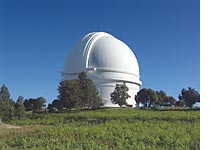|
|
Palomar Observatory.
Home of the Hale Telescope.
Palomar Mountain Observatory in California
 High atop San Diego’s Mt. Palomar is the famous Palomar Observatory, home of the 200-inch Hale Telescope. The Observatory is located within the Cleveland National Forest on Palomar Mountain in north San Diego County at an elevation of 5,500 feet above sea level. The California Institute of Technology owns and operates the observatory. Open to the public, the observatory is an active research center. Scientists arrive in the evening after the doors are shut to the public to view the universe and conduct their studies. High atop San Diego’s Mt. Palomar is the famous Palomar Observatory, home of the 200-inch Hale Telescope. The Observatory is located within the Cleveland National Forest on Palomar Mountain in north San Diego County at an elevation of 5,500 feet above sea level. The California Institute of Technology owns and operates the observatory. Open to the public, the observatory is an active research center. Scientists arrive in the evening after the doors are shut to the public to view the universe and conduct their studies.
Palomar Observatory is home to five telescopes with the 200-inch Hale being the largest and best known. The telescopes are involved in a wide
variety of astronomical research programs. The studies conducted range from the hunt for near-Earth asteroids to probing distant galaxies and quasars at the farthest reaches of the universe. Exhibits and interactive kiosks tell the story of the observatory. Here you can tour the solar system and learn about Supernovae and Gamma Ray Bursts.
The public may visit between 9:00 – 4:00 for self guided tours (closed on December 24-25th). Guided tours are available for educational groups on a reservation only basis. Public guided tours are held every Saturday at 11:30 and 1:30 from May through October. Tour tickets are sold in the gift shop and range in price from $2.50 - $5.00 depending on age. Children 5 and under free. For the handicapped, special access is held at 9:30, 1:00, and 3:45.
The interior of the dome housing the Hale Telescope is kept cool to maintain night time mountain temperatures. Visitors should bring jackets, even on hot days.
Membership has its privileges at Mt. Palomar. Members gain access to special events and night time lectures followed by viewing the stars through the observatory’s telescopes. Most of these events are intimate gatherings limited to a small number of guests on a first come, first served basis.
For more information and directions visit the Palomar Observatory website.
|
|

